The global industrial drying cabinets market is projected to grow from USD 980.0 million in 2025 to approximately USD 1,450.6 million by 2035, recording an absolute increase of USD 470.8 million over the forecast period. This translates into a total growth of 48.0%, with the market forecast to expand at a compound annual growth rate (CAGR) of 4.0% between 2025 and 2035. The overall market size is expected to grow by nearly 1.48X during the same period, supported by the rising demand for precision drying solutions across laboratories, pharmaceutical manufacturing, and electronics sectors, along with increasing adoption of advanced temperature-controlled drying equipment.
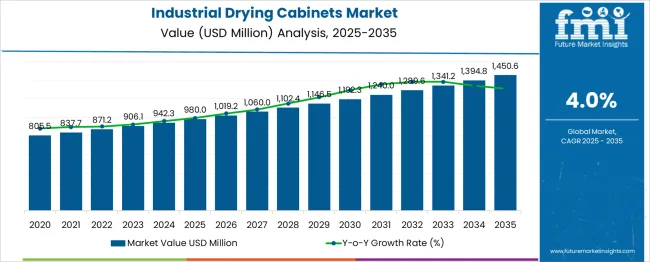
Between 2025 and 2030, the industrial drying cabinets market is projected to expand from USD 980.0 million to USD 1192.4 million, resulting in a value increase of USD 212.4 million, which represents 45.1% of the total forecast growth for the decade. This phase of growth will be shaped by rising demand for laboratory automation, increasing pharmaceutical R&D activities requiring precise drying conditions, and growing adoption of energy-efficient drying solutions in manufacturing processes. Equipment manufacturers are expanding their product portfolios to address the growing complexity of modern industrial drying requirements across various temperature ranges and applications.
From 2030 to 2035, the market is forecast to grow from USD 1,192.4 million to USD 1,450.6 million, adding another USD 258.4 million, which constitutes 54.9% of the overall ten-year expansion. This period is expected to be characterized by expansion of smart drying cabinet solutions with IoT connectivity, integration of advanced temperature and humidity control systems, and development of specialized drying protocols for emerging applications in biotechnology and advanced materials processing. The growing adoption of Industry 4.0 principles will drive demand for more sophisticated drying equipment with real-time monitoring and data logging capabilities.
| Metric | Value |
|---|---|
| Estimated Value in (2025E) | USD 980.0 million |
| Forecast Value in (2035F) | USD 1,450.6 million |
| Forecast CAGR (2025 to 2035) | 4.0% |
Between 2020 and 2025, the industrial drying cabinets market experienced steady expansion, driven by increasing laboratory automation trends, growing pharmaceutical manufacturing activities, and rising quality control requirements across various industries. The market developed as research institutions and manufacturing facilities recognized the need for reliable, precise drying equipment to maintain product quality and comply with regulatory standards. The COVID-19 pandemic accelerated demand for laboratory equipment, including drying cabinets, as testing and research activities intensified globally.
Market expansion is being supported by the rapid growth in pharmaceutical and biotechnology research activities worldwide and the corresponding need for precise, controlled drying environments for sample preparation and material processing. Modern industrial processes require exact temperature and humidity control to ensure product quality, regulatory compliance, and process repeatability. Even minor variations in drying conditions can significantly impact final product characteristics, driving demand for advanced drying cabinet solutions with superior temperature uniformity and control capabilities.
The growing complexity of manufacturing processes and increasing regulatory requirements are driving demand for certified drying equipment from reputable manufacturers with validated performance specifications. Quality assurance protocols in pharmaceuticals, electronics, and food processing industries require documented drying procedures and equipment validation. Regulatory compliance standards such as Good Manufacturing Practice (GMP) and Good Laboratory Practice (GLP) are establishing stringent requirements for drying equipment that necessitate advanced control systems and comprehensive documentation capabilities.
The market is segmented by heating method, temperature range, size/form, end-use sector, and region. By heating method, the market is divided into electric, gas, and steam/other heating systems. Based on temperature range, the market is categorized into ≤120°C, 121-200°C, and >200°C. In terms of size/form, the market is segmented into benchtop, floor-standing, and walk-in configurations. By end-use sector, the market is classified into labs & pharma QA/QC, electronics & components, manufacturing/MRO, healthcare, and others. Regionally, the market is divided into North America, Europe, Asia Pacific, Latin America, and Middle East & Africa.
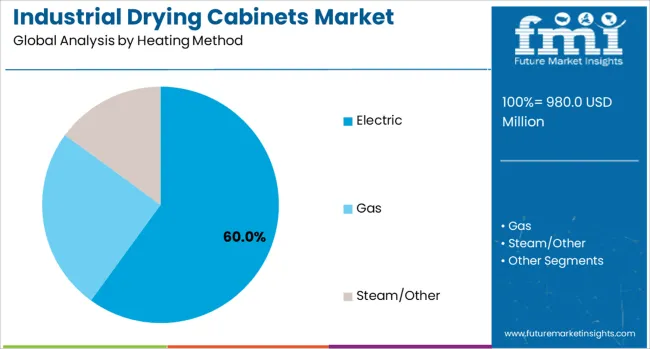
The electric heating segment is projected to account for 60% of the industrial drying cabinets market in 2025, reflecting its position as the dominant heating method. Electric systems are widely adopted due to their precision temperature control, stable performance, and relatively simple installation requirements compared to gas or steam alternatives. These cabinets provide superior uniformity and stability, making them the preferred option in laboratories, pharmaceutical production, and electronic component drying, where precise conditions are critical.
Electric heating also aligns with stricter environmental and workplace safety standards, as it eliminates combustion emissions and reduces operator risks. Comprehensive safety features such as over-temperature protection and programmable controllers further support adoption. With growing demand for clean, controlled, and energy-efficient drying systems across industrial and research sectors, electric heating is set to remain the most reliable and trusted technology in industrial drying cabinet applications.
.webp)
The 121-200°C temperature range is expected to represent 45% of industrial drying cabinet demand in 2025, underscoring its importance as the most widely applicable operational band. This range provides effective moisture removal while avoiding thermal degradation of sensitive materials, making it ideal for pharmaceuticals, electronics, polymers, and general manufacturing. Many industrial processes, including sample preparation, material conditioning, and quality assurance testing, fall within this temperature zone, reinforcing its broad adoption.
The segment benefits from versatility, as cabinets in this range can serve both low- and medium-intensity drying requirements with adjustable precision. Additionally, energy efficiency is optimized within this range, balancing effective performance with manageable operational costs. Regulatory compliance in laboratory and production environments further supports adoption, as consistent performance between 121°C and 200°C ensures reliability. This makes the range the most practical and widely demanded for diverse industrial drying cabinet applications.
Floor-standing drying cabinets are projected to account for 60% of the industrial drying cabinets market in 2025, establishing themselves as the most versatile configuration. These units offer significantly larger internal volumes than benchtop or compact alternatives, allowing for batch processing and accommodation of a wide variety of sample sizes. Floor-standing models typically feature multiple shelving options, reinforced structures, and advanced airflow systems that promote uniform drying across all levels.
Their scalability makes them suitable for both small-scale laboratories and large-scale manufacturing facilities. Demand is driven by industries requiring high-capacity, continuous operation solutions, such as pharmaceuticals, automotive, and electronics. Workflow integration and ergonomic accessibility further support adoption, as these cabinets can be seamlessly incorporated into industrial production lines. Their flexibility and durability ensure floor-standing cabinets remain the preferred choice across diverse end-use applications.
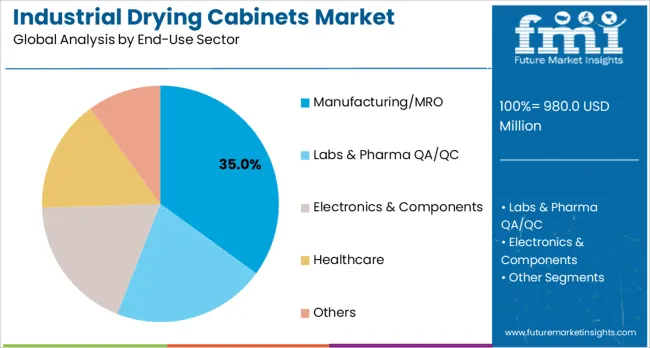
The manufacturing and MRO (maintenance, repair, and operations) sector is expected to hold 35% of the industrial drying cabinets market in 2025, highlighting its role as the largest end-use segment. Manufacturing facilities rely on drying cabinets for essential processes such as component conditioning, material preparation, coating curing, and post-production quality control. In MRO applications, drying cabinets are critical for ensuring reliability and longevity of spare parts, tools, and assemblies subjected to moisture-sensitive conditions.
Industrial-grade drying solutions are favored for their robust construction, continuous operation capabilities, and ability to maintain consistent performance under demanding conditions. This sector is also supported by regulatory and quality standards requiring precise conditioning for critical components, particularly in automotive, aerospace, and heavy machinery industries. As manufacturing complexity grows, reliable drying equipment remains integral to both productivity and compliance, ensuring steady demand from the manufacturing and MRO segment.
The industrial drying cabinets market is advancing steadily due to increasing laboratory automation and growing recognition of precise drying process importance. However, the market faces challenges including high initial equipment costs, need for regular maintenance and calibration, and varying drying requirements across different applications and materials. Energy efficiency regulations and environmental sustainability concerns continue to influence equipment design and market development patterns.
The growing deployment of IoT-enabled drying cabinets is enabling remote monitoring, predictive maintenance, and comprehensive data logging capabilities. Smart drying systems equipped with advanced sensors and connectivity features provide real-time process monitoring and automated documentation for regulatory compliance. These technologies are particularly valuable for pharmaceutical and research applications that require detailed process records and validation data for quality assurance purposes.
Modern drying cabinet manufacturers are incorporating advanced PID control systems and multi-zone temperature management that improve drying uniformity and reduce processing times. Integration of humidity control capabilities and real-time environmental monitoring enables more precise process control and better product quality outcomes. Advanced control systems also support complex drying protocols and automated recipe management for consistent results across different applications and operators.
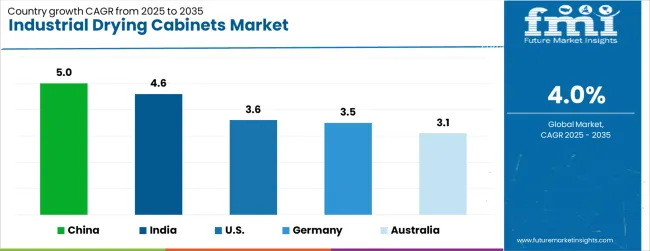
| Country | CAGR (2025 to 2035) |
|---|---|
| China | 5.0% |
| India | 4.6% |
| USA | 3.6% |
| Germany | 3.5% |
| Australia | 3.1% |
The industrial drying cabinets market is growing rapidly, with China leading at a 5.0% CAGR through 2035, driven by expanding pharmaceutical manufacturing, electronics production growth, and increasing laboratory infrastructure development. India follows at 4.6%, supported by rising pharmaceutical exports, growing biotechnology sector, and increasing quality control requirements in manufacturing. The USA grows steadily at 3.6%, focusing on laboratory automation and advanced research applications. Germany records 3.5%, emphasizing precision engineering and advanced manufacturing processes. Australia shows stable growth at 3.1%, driven by mining laboratory applications and pharmaceutical research expansion. Overall, China and India emerge as the leading drivers of global industrial drying cabinet market expansion.
The report covers an in-depth analysis of 40+ countries; five top-performing countries are highlighted below.
Revenue from industrial drying cabinets in China is projected to exhibit the highest growth rate with a CAGR of 5.0% through 2035, driven by rapid expansion of pharmaceutical manufacturing capabilities and increasing demand for quality control equipment in electronics production. The country's growing biotechnology sector and expanding laboratory infrastructure are creating significant demand for advanced drying solutions. Major manufacturing companies and research institutions are establishing comprehensive drying equipment capabilities to support quality assurance and regulatory compliance requirements across various industries.
Revenue from industrial drying cabinets in India is expanding at a CAGR of 4.6%, supported by increasing pharmaceutical exports and growing biotechnology research activities requiring precise drying capabilities. The country's expanding contract research organization (CRO) sector and increasing generic drug manufacturing are driving demand for reliable drying equipment. Pharmaceutical companies and research institutions are gradually establishing advanced laboratory capabilities to serve both domestic and international markets with validated drying processes.
Demand for industrial drying cabinets in the USA is projected to grow at a CAGR of 3.6%, supported by increasing laboratory automation and growing emphasis on research and development activities across pharmaceutical and biotechnology sectors. Large research institutions and pharmaceutical companies are implementing advanced drying solutions to improve process efficiency and ensure regulatory compliance. The market benefits from established infrastructure, comprehensive service networks, and strong emphasis on equipment validation and documentation requirements.
Demand for industrial drying cabinets in Germany is expanding at a CAGR of 3.5%, driven by the country's emphasis on precision manufacturing and stringent quality control requirements across various industries. German manufacturers and research institutions are implementing comprehensive drying solutions that meet rigorous performance standards and regulatory specifications. The market is characterized by focus on engineering excellence, advanced temperature control systems, and compliance with comprehensive safety and environmental regulations.
Revenue from industrial drying cabinets in Australia is growing at a CAGR of 3.1%, driven by expanding mining laboratory applications and increasing pharmaceutical research activities requiring precise sample preparation and analysis capabilities. The country's established mining industry and growing biotechnology sector are creating consistent demand for reliable drying equipment. Research institutions and industrial laboratories are investing in advanced drying solutions to support analytical testing and quality control operations across various sectors.
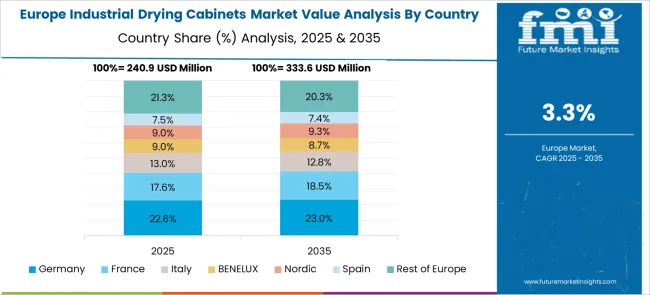
The European industrial drying cabinets market demonstrates advanced development across major economies with Germany leading through its precision instrumentation capabilities and strong laboratory equipment sector, supported by companies like Binder GmbH and Memmert pioneering innovative drying technologies for diverse industrial and laboratory applications. The UK shows significant growth through companies like LEEC Ltd and Cole-Parmer (Stuart), serving pharmaceutical and research sectors where stringent quality standards drive demand for reliable drying solutions. German manufacturers leverage their engineering expertise to develop comprehensive temperature-controlled systems, while international players like Thermo Fisher (Heratherm) and VWR/Avantor establish strong European presence.
France, Italy, and Spain exhibit expanding adoption in pharmaceutical manufacturing and quality control applications, driven by regulatory compliance requirements and manufacturing modernization initiatives. Nordic countries emphasize sustainable laboratory practices and energy-efficient solutions, while Eastern European markets show growing interest in upgrading research and manufacturing infrastructure. The market benefits from strict regulatory standards, quality control requirements, and the region's leadership in precision instrumentation, positioning Europe as a key innovation center for next-generation industrial drying solutions.

The industrial drying cabinets market is characterized by competition among established equipment manufacturers, specialized laboratory equipment providers, and industrial automation companies. Companies are investing in advanced temperature control systems, energy-efficient designs, smart connectivity features, and comprehensive service capabilities to deliver reliable, precise, and user-friendly drying solutions. Strategic partnerships, technological innovation, and global distribution networks are central to strengthening product portfolios and market presence.
Binder GmbH, Germany-based, offers precision drying cabinets with advanced temperature control and superior uniformity for laboratory and industrial applications. Blue M (TPS), USA-based, provides robust industrial drying solutions with comprehensive temperature ranges and reliable performance. Cole-Parmer (Stuart), operating in USA/UK, delivers versatile drying equipment with user-friendly controls and comprehensive safety features. Esco Lifesciences, Singapore-based, emphasizes laboratory-grade drying solutions with advanced airflow and contamination control.
Fisherbrand (OEM), USA-based, offers comprehensive drying cabinet solutions integrated with laboratory supply networks and service support. LEEC Ltd, UK-based, provides specialized drying equipment with custom configurations and application-specific designs. Memmert, Germany-based, delivers precision drying technology with advanced control systems and energy efficiency. Thermo Fisher (Heratherm), VWR/Avantor, and Yamato Scientific offer comprehensive drying solutions with global service networks, standardized procedures, and application expertise across diverse industrial and laboratory markets.
| Items | Values |
|---|---|
| Quantitative Units (2025) | USD 980.0 million |
| Heating Method | Electric, Gas, Steam/Other |
| Temperature Range | ≤120°C, 121-200°C, >200°C |
| Size/Form | Benchtop, Floor-Standing, Walk-in |
| End-Use Sector | Labs & Pharma QA/QC, Electronics & Components, Manufacturing/MRO, Healthcare, Others |
| Regions Covered | North America, Europe, Asia Pacific, Latin America, Middle East & Africa |
| Countries Covered | United States, Canada, United Kingdom, Germany, France, China, Japan, South Korea, Brazil, Australia and 40+ countries |
| Key Companies Profiled | Binder GmbH, Blue M (TPS), Cole-Parmer (Stuart), Esco Lifesciences, Fisherbrand (OEM), LEEC Ltd, Memmert, Thermo Fisher (Heratherm), VWR/Avantor, and Yamato Scientific |
| Additional Attributes | Dollar sales by heating technology and capacity range, regional demand trends, competitive landscape, buyer preferences for standard versus custom units, integration with smart factory/IoT platforms, innovations in energy-efficient drying, uniform airflow control, and sustainable insulation materials |
The global industrial drying cabinets market is estimated to be valued at USD 980.0 million in 2025.
The market size for the industrial drying cabinets market is projected to reach USD 1,450.6 million by 2035.
The industrial drying cabinets market is expected to grow at a 4.0% CAGR between 2025 and 2035.
The key product types in industrial drying cabinets market are electric, gas and steam/other.
In terms of temperature range (°c), 121–200 segment to command 45.0% share in the industrial drying cabinets market in 2025.






Our Research Products

The "Full Research Suite" delivers actionable market intel, deep dives on markets or technologies, so clients act faster, cut risk, and unlock growth.

The Leaderboard benchmarks and ranks top vendors, classifying them as Established Leaders, Leading Challengers, or Disruptors & Challengers.

Locates where complements amplify value and substitutes erode it, forecasting net impact by horizon

We deliver granular, decision-grade intel: market sizing, 5-year forecasts, pricing, adoption, usage, revenue, and operational KPIs—plus competitor tracking, regulation, and value chains—across 60 countries broadly.

Spot the shifts before they hit your P&L. We track inflection points, adoption curves, pricing moves, and ecosystem plays to show where demand is heading, why it is changing, and what to do next across high-growth markets and disruptive tech

Real-time reads of user behavior. We track shifting priorities, perceptions of today’s and next-gen services, and provider experience, then pace how fast tech moves from trial to adoption, blending buyer, consumer, and channel inputs with social signals (#WhySwitch, #UX).

Partner with our analyst team to build a custom report designed around your business priorities. From analysing market trends to assessing competitors or crafting bespoke datasets, we tailor insights to your needs.
Supplier Intelligence
Discovery & Profiling
Capacity & Footprint
Performance & Risk
Compliance & Governance
Commercial Readiness
Who Supplies Whom
Scorecards & Shortlists
Playbooks & Docs
Category Intelligence
Definition & Scope
Demand & Use Cases
Cost Drivers
Market Structure
Supply Chain Map
Trade & Policy
Operating Norms
Deliverables
Buyer Intelligence
Account Basics
Spend & Scope
Procurement Model
Vendor Requirements
Terms & Policies
Entry Strategy
Pain Points & Triggers
Outputs
Pricing Analysis
Benchmarks
Trends
Should-Cost
Indexation
Landed Cost
Commercial Terms
Deliverables
Brand Analysis
Positioning & Value Prop
Share & Presence
Customer Evidence
Go-to-Market
Digital & Reputation
Compliance & Trust
KPIs & Gaps
Outputs
Full Research Suite comprises of:
Market outlook & trends analysis
Interviews & case studies
Strategic recommendations
Vendor profiles & capabilities analysis
5-year forecasts
8 regions and 60+ country-level data splits
Market segment data splits
12 months of continuous data updates
DELIVERED AS:
PDF EXCEL ONLINE
Industrial Bench Scale Market Size and Share Forecast Outlook 2025 to 2035
Industrial Low Profile Floor Scale Market Size and Share Forecast Outlook 2025 to 2035
Industrial Sand Mill Market Size and Share Forecast Outlook 2025 to 2035
Industrial Control Network Modules Market Size and Share Forecast Outlook 2025 to 2035
Industrial Precision Oven Market Size and Share Forecast Outlook 2025 to 2035
Industrial Water Chiller for PCB Market Size and Share Forecast Outlook 2025 to 2035
Industrial & Commercial HVLS Fans Market Size and Share Forecast Outlook 2025 to 2035
Industrial Robot Controller Market Size and Share Forecast Outlook 2025 to 2035
Industrial Wired Routers Market Size and Share Forecast Outlook 2025 to 2035
Industrial Evaporative Condensers Market Size and Share Forecast Outlook 2025 to 2035
Industrial Energy Management System Market Size and Share Forecast Outlook 2025 to 2035
Industrial Insulation Market Size and Share Forecast Outlook 2025 to 2035
Industrial Safety Gloves Market Size and Share Forecast Outlook 2025 to 2035
Industrial Cleaner Market Size and Share Forecast Outlook 2025 to 2035
Industrial Dust Treatment System Market Size and Share Forecast Outlook 2025 to 2035
Industrial Vertical Washing Tower Market Size and Share Forecast Outlook 2025 to 2035
Industrial Pepper Market Size and Share Forecast Outlook 2025 to 2035
Industrial Electronics Packaging Market Forecast and Outlook 2025 to 2035
Industrial Absorbent Market Forecast and Outlook 2025 to 2035
Industrial Furnace Industry Analysis in Europe Forecast and Outlook 2025 to 2035

Thank you!
You will receive an email from our Business Development Manager. Please be sure to check your SPAM/JUNK folder too.
Chat With
MaRIA